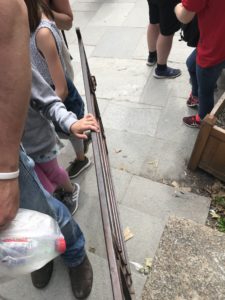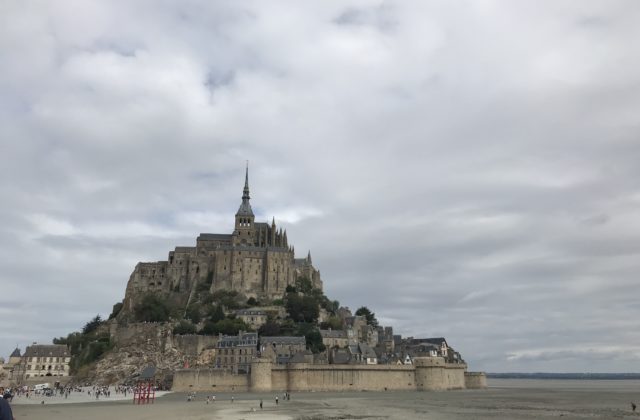Sermon on the Mont: What Monument Will We Leave Behind?
Yes it is beautiful. And yes it is historic. And yes it is one of those “must see” places. But let’s face it, Mont Saint Michel is what could be considered, like many beautiful and historic places, a tourist trap. Located in Normandy about 4 hours west of Paris, the abbey and town are right up there with the Taj Mahal, the Empire State Building, or the Leaning Tower of Pisa. We’ve all seen pictures of these places, and while we may not know exactly where these places are, their historical significance, or much about them at all, we intuitively know they are important. Two things about my recent trip there: it exceeded my expectations and I had a un petite révélation about innovation while I was there.
I’m not going to give you a boring travel log here. But it is enough to say that I was on a trip that took my companions and me to Mont Saint Michel. We braced for the worst. Really braced, packing lunch and our minds with visions of endless lines, no bathrooms, and the pungent aroma of sweaty bodies from all over the world gently rinsed by a steady rain. It was as one companion said, “going to be a shit show.”
It was not. I had just come from England where I waited in a snaking line to get into Westminster Abbey. Again, no travel log here, but I fully expected a Norman version of the Abbey parked on a quaintly inaccessible mountain. I visited and saw many abbeys and they are important. But this one seemed to dial up the difficultly level to 11; I envisioned a long snaking line across the sand to a tiny door. Yay! An abbey. Where’s the restroom? And don’t call me an ugly American. My whole trip was all about history and seeing and being in place to smell, touch, and feel everything I could about what otherwise might seem like just a field, a pile of bricks, or a plaque on a wall.
Instead of our visions of a sclerotic and wending cue, a fast moving line preceded the quick trip by bus from a parking lot some distance from the site to the entrance. We crammed into the bus and saw plenty of restaurants and amenities along the causeway. And it really didn’t take that long to get there. And no, it isn’t just another abbey on big rock; it is a town, a very small town, but a very compact and pleasing town surrounding an abbey. The town and abbey are linked by a series of streets that wrap around the rock, full of shops and restaurants and bars and hotels held together by a wall the top of which functions as a street too.
So if you find yourself in Normandy, go to Mont Saint Michel. Plan to stay for the day and enjoy the wall and the walk and yes, the aroma of the sweaty tourists around you. And if you’re with others, get them all wound up about how the place is the second most visited spot in France and that there will be lots of crowds and walking; and then watch them be stunned by the concentrated and dense beauty and culinary opportunity of the place not to mention the history and the architecture and the efficiency. The town is an example of how density is efficient and that when land is used well, putting more people and things in a compact place, transportation is efficient too.
And the revelation? Well, after walking all the way to the entrance of the abbey, we were ready for our picnic lunch (or peek neek, as they say. Be sure to practice your French accent before you go). We were looking for a place to sit. There was a perfectly good set of steps with a small green sward in front of them. It was a great spot for lunch. But there was a rusty gate about three feet high in front of the small, narrow courtyard. It would be easy to just step over it. Nobody did. We didn’t. We found a spot above it on some different steps. I couldn’t help but wonder why the crowd, with many in it just like us, looking for the right spot, just didn’t step over the little gate. Somebody would come rushing out for sure and shoo people away. Maybe it was something important. Maybe anyone stepping over the gate would be banned from the place for life, or worse.
Well, someone took the risk. While we were eating lunch, someone finally decided to step over the fence. Then someone else followed. Then another. Soon, the little courtyard was as full of people as anyplace else with a flat surface to sit and some shade.

That’s how innovation works. One person decides to do it, jump the fence, and take the space. What will happen? Everyone watches. Then the next person says, “Yes, let’s do it.” Then another. And another. Then it becomes just another space filled with people. But someone has to take that first step, leap, or jump. Someone has to try, to make the call, to make the effort; and they have to wonder about the consequences whether they are official or simply the disapprobation of everyone else that doesn’t follow into the new space but is scandalized or perhaps envious.
I guess this is true of Mont Saint Michel itself. There are a lot of easier places to build a town and an abbey; and this is why it is a “must see.”
Some people resent innovation. They want equality. Some people want everyone to have government enforced equal access to everything that everyone wants, whether it is a place to sit, or a job, or place to live. Sure, let’s try that. But what would be inevitable is that some people just wouldn’t be able to see the city or the abbey at all because they’d have to wait their turn. And maybe the abbey and town wouldn’t have been allowed to be built at all since not everyone could get in and have the same exact experience.
Equal access to scarcity means some get in and some don’t; those that do win, those that don’t wait. Innovation means everyone gets to try to get in, even if it means jumping a fence to do it. This is not an ideological point; scarcity is part of how the world works. Poverty – lacking something – isn’t desirable or fun and can be deadly, but thus it motivates innovation, fence jumping and building something in order to get out of it. If poverty didn’t exist, neither would civilization and the things we value about it. We can guarantee a right to something that doesn’t exist, or we can let people find ways to make more, open new paths, find new solutions, and yes, make more money doing it.
Will we leave a monument to scarcity or abundance? Will we shame and penalize people who try something new because we envy them? When it comes to housing the answer is up to us and it is also obvious: let people climb the mountain, jump the fence, and make more.



